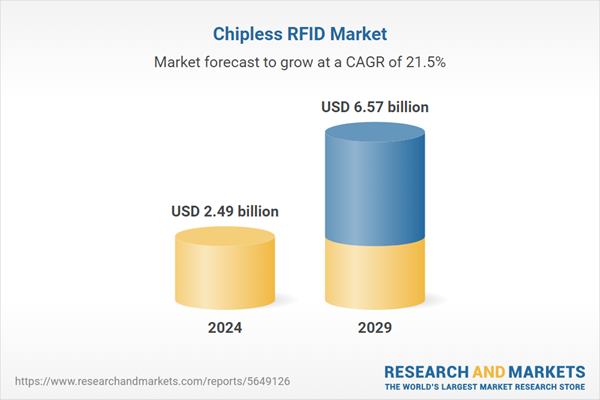The chipless RFID market is expected to grow at a CAGR of 21.46%, reaching a market size of US$6.574 billion in 2029 from US$2.488 billion in 2024.
Worldwide, numerous industries, from retail to logistics, healthcare, pro automotive, and the skies, are embracing the use of chipless RFID technology. Compared to the conventional chip-based RFID systems, advantages such as non-line-of-sight identification, real-time tracking, and cost-effectiveness have attracted many people to adopt chipless RFID technology. The retail industry has positively affected the world’s demand for improved controls over inventory management, better customer service delivery, and more efficient operations, for example.
Chipless RFID technology helps retail stores achieve smooth checkout processes, reduce stock-outs and product visibility, and optimize their e-stock levels, among others. On top of that, pharmaceutical and health industries have started using this kind of technology for various purposes, such as drug distribution, asset management, and patient monitoring.
Worldwide, numerous industries, from retail to logistics, healthcare, pro automotive, and the skies, are embracing the use of chipless RFID technology. Compared to the conventional chip-based RFID systems, advantages such as non-line-of-sight identification, real-time tracking, and cost-effectiveness have attracted many people to adopt chipless RFID technology. The retail industry has positively affected the world’s demand for improved controls over inventory management, better customer service delivery, and more efficient operations, for example.
Chipless RFID technology helps retail stores achieve smooth checkout processes, reduce stock-outs and product visibility, and optimize their e-stock levels, among others. On top of that, pharmaceutical and health industries have started using this kind of technology for various purposes, such as drug distribution, asset management, and patient monitoring.
Chipless RFID Market Drivers:
- Increased reading range
Chipless RFID Market Geographical Outlook
- North America is witnessing exponential growth during the forecast period
Reasons for buying this report::
- Insightful Analysis: Gain detailed market insights covering major as well as emerging geographical regions, focusing on customer segments, government policies and socio-economic factors, consumer preferences, industry verticals, other sub- segments.
- Competitive Landscape: Understand the strategic maneuvers employed by key players globally to understand possible market penetration with the correct strategy.
- Market Drivers & Future Trends: Explore the dynamic factors and pivotal market trends and how they will shape up future market developments.
- Actionable Recommendations: Utilize the insights to exercise strategic decision to uncover new business streams and revenues in a dynamic environment.
- Caters to a Wide Audience: Beneficial and cost-effective for startups, research institutions, consultants, SMEs, and large enterprises.
What do businesses use our reports for?
Industry and Market Insights, Opportunity Assessment, Product Demand Forecasting, Market Entry Strategy, Geographical Expansion, Capital Investment Decisions, Regulatory Framework & Implications, New Product Development, Competitive IntelligenceReport Coverage:
- Historical data & forecasts from 2022 to 2029
- Growth Opportunities, Challenges, Supply Chain Outlook, Regulatory Framework, Customer Behaviour, and Trend Analysis
- Competitive Positioning, Strategies, and Market Share Analysis
- Revenue Growth and Forecast Assessment of segments and regions including countries
- Company Profiling (Strategies, Products, Financial Information, and Key Developments among others)
The Chipless RFID market is segmented and analyzed as follows:
- By Product
- Tag
- Reader
- Middleware
- By Frequency
- Low Frequency
- High Frequency
- Ultrahigh Frequency
- By End-User Industry
- Retail
- Aerospace and Defense
- Travel and Transport/Logistics
- Healthcare
- Others
- By Geography
- North America
- USA
- Canada
- Mexico
- South America
- Brazil
- Argentina
- Others
- Europe
- Germany
- France
- United Kingdom
- Spain
- Others
- Middle East and Africa
- Saudi Arabia
- Israel
- South Africa
- Others
- Asia Pacific
- China
- Japan
- South Korea
- India
- Others
- North America
Table of Contents
1. INTRODUCTION
2. RESEARCH METHODOLOGY
3. EXECUTIVE SUMMARY
4. MARKET DYNAMICS
5. CHIPLESS RFID MARKET BY PRODUCT
6. CHIPLESS RFID MARKET BY FREQUENCY
7. CHIPLESS RFID MARKET BY END-USER INDUSTRY
8. CHIPLESS RFID MARKET BY GEOGRAPHY
8.3. South America
9. COMPETITIVE ENVIRONMENT AND ANALYSIS
10. COMPANY PROFILES
Companies Mentioned
Some of the key companies profiled in this Chipless RFID Market report include:- Alien Technology Corporation
- Qualcomm (NXP Semiconductor NV)
- Variuscard GmbH
- SATO Vicinity Pty. Ltd.
- Matrix (Zebra Technologies)
- Beontag (Confidex Ltd.)
- Honeywell (Intermec)
- Identiv Inc.
- Impinj Inc.
Methodology

LOADING...
Table Information
| Report Attribute | Details |
|---|---|
| No. of Pages | 126 |
| Published | September 2024 |
| Forecast Period | 2024 - 2029 |
| Estimated Market Value ( USD | $ 2.49 billion |
| Forecasted Market Value ( USD | $ 6.57 billion |
| Compound Annual Growth Rate | 21.4% |
| Regions Covered | Global |
| No. of Companies Mentioned | 10 |









